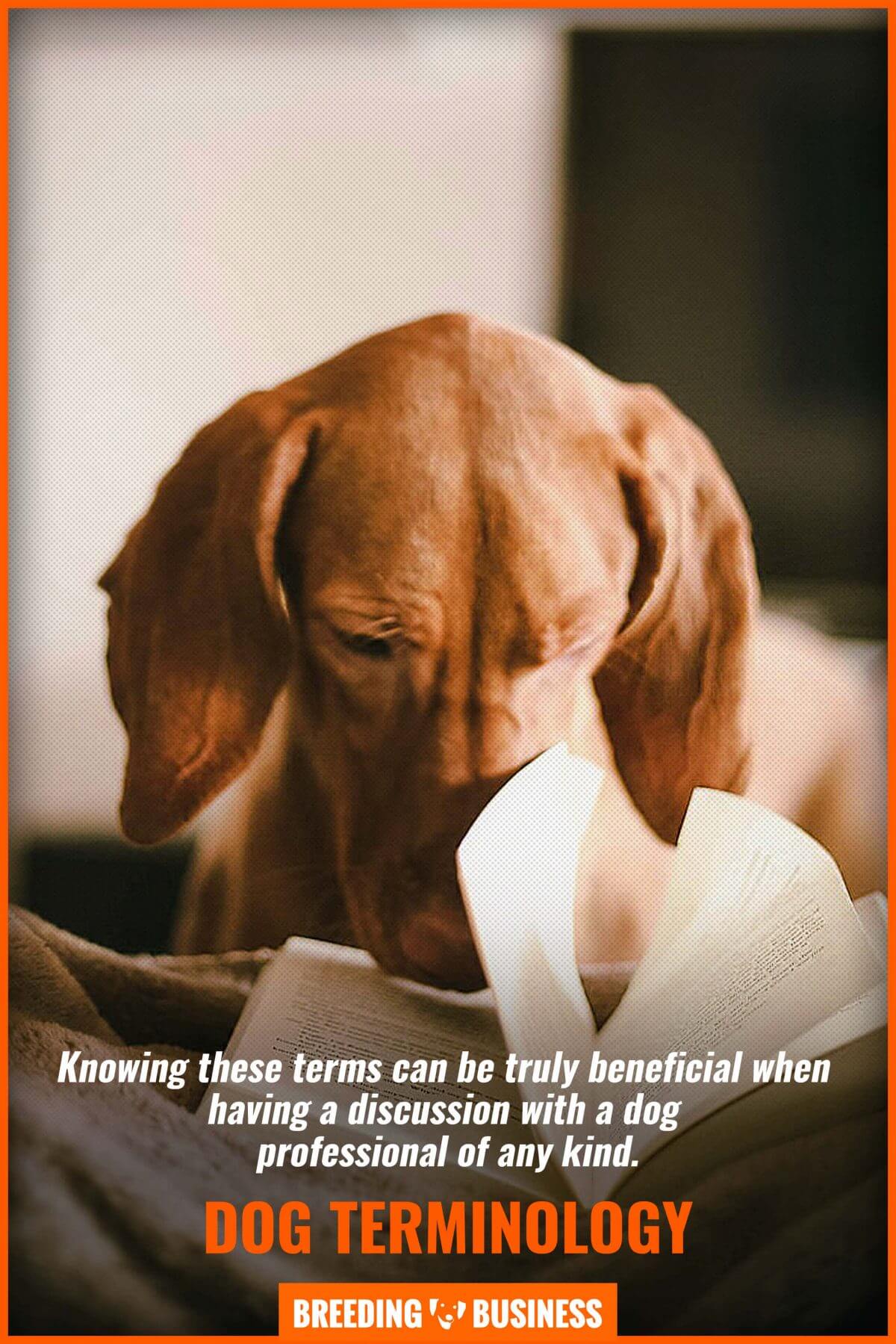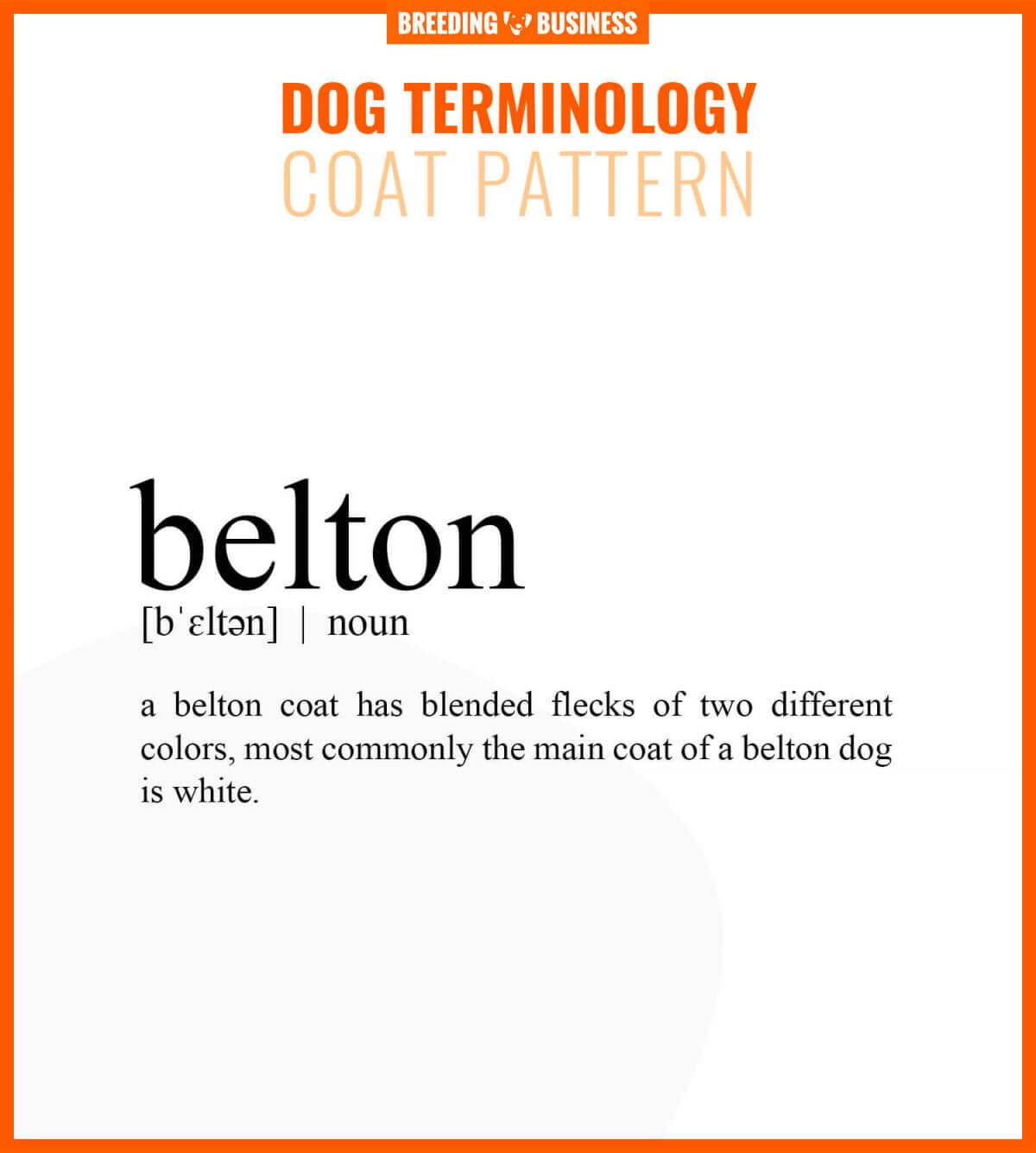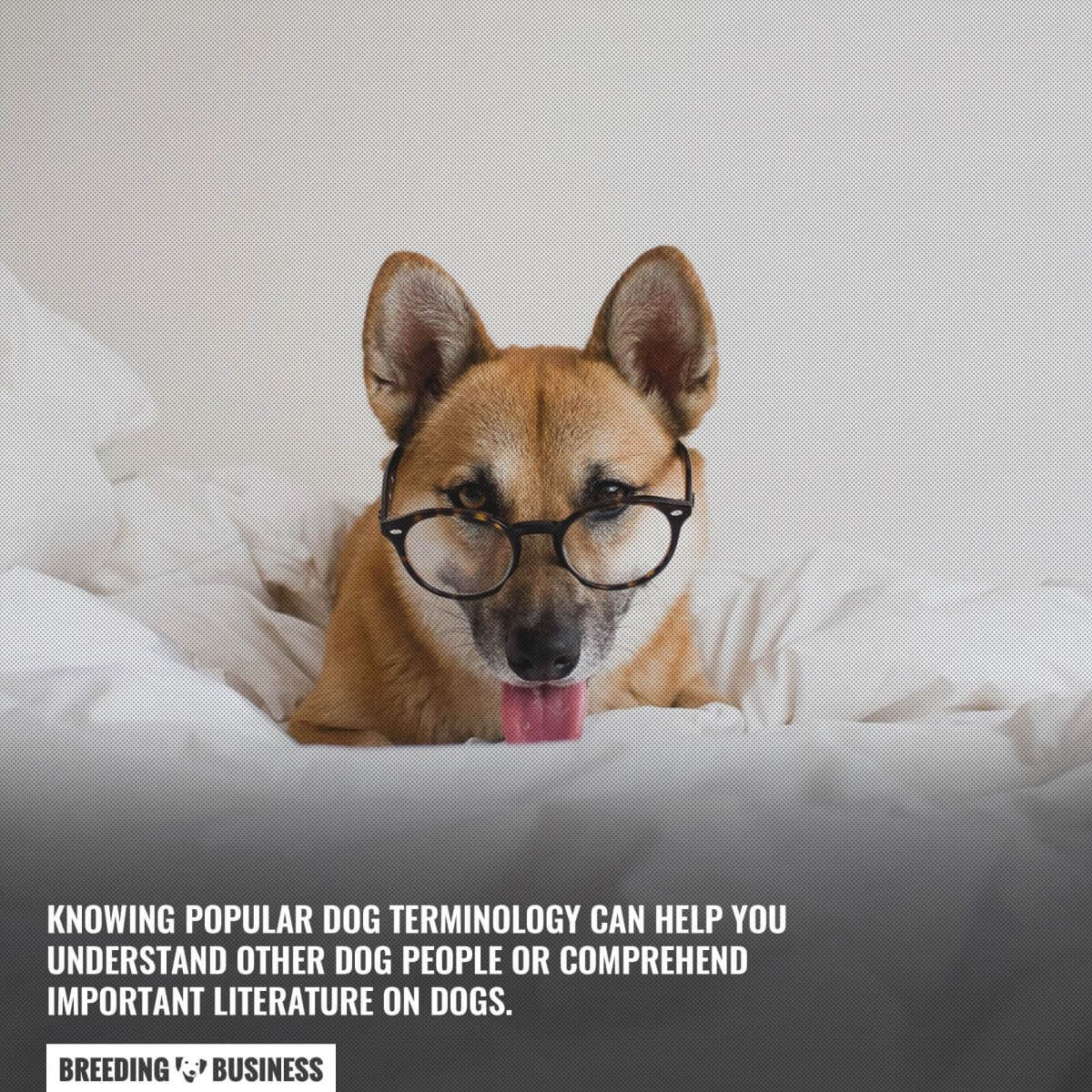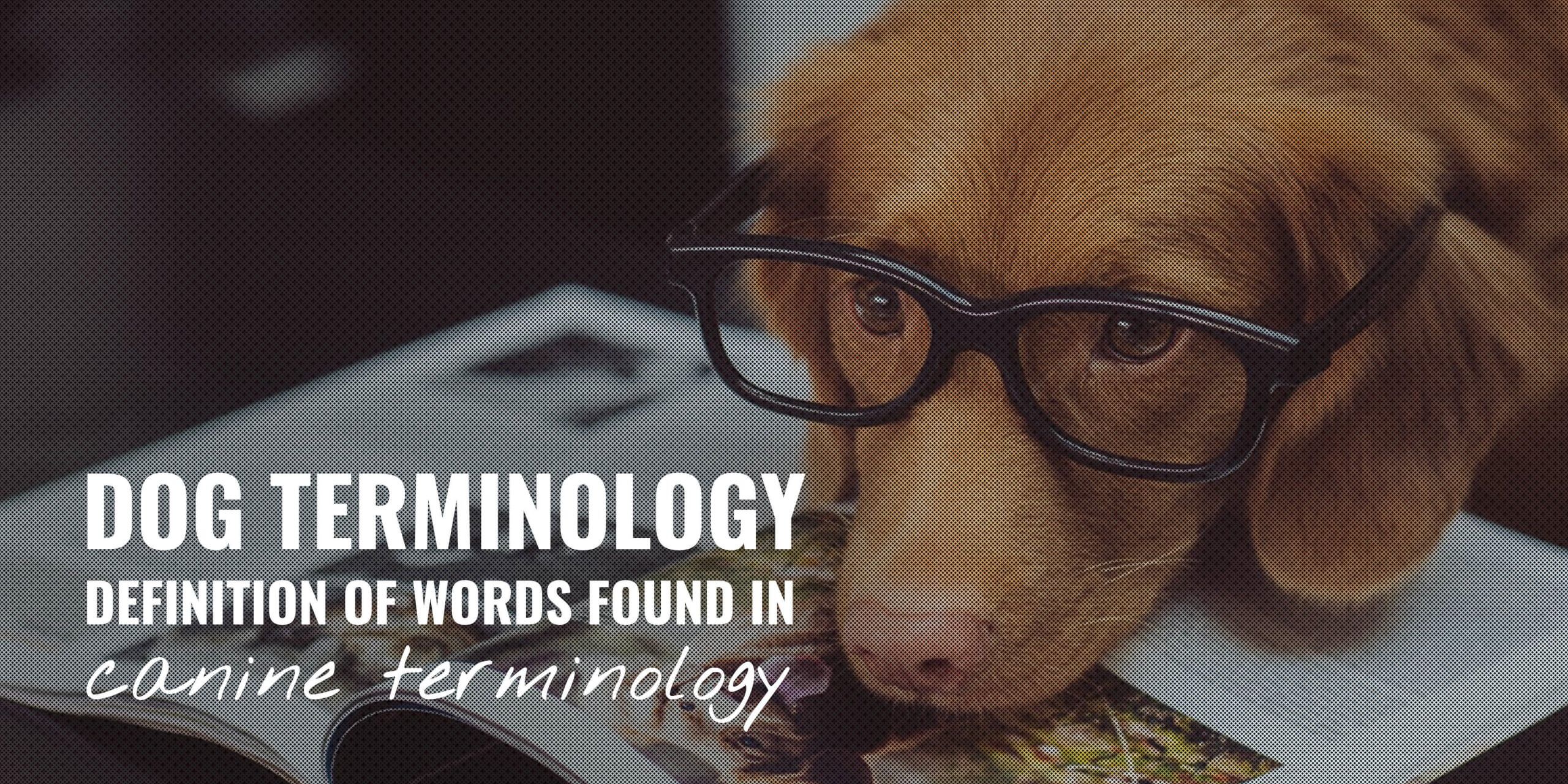Knowing popular dog terminology can help you understand other dog people or comprehend important literature on dogs. If you are interested in delving into the world of dogs, such as considering AKC shows, understanding these keywords will be very helpful.
Breeders and dog shows use these terms more often than other dog professions. So if you are considering dog shows or breeding, these terms will be useful to you.
This list highlights some of the most important and commonly used canine terminology and provides a concise summary to help your understanding. From slang to descriptive keywords, read on to find out more.
Why is it Important to Know Dog Terminology
Anyone can be a dog lover, so why is it necessary for someone to learn all this terminology about dogs? Knowing these terms can be truly beneficial when having a discussion with a dog professional of any kind. Those with dog show specifications may use the terminology to explain the breed standard and possible faults. Breeders will use these terms as descriptors when selling puppies or even describing their genetic lineage. Understanding dog terminology will prevent you from feeling confused or isolated in these conversations. Furthermore, they are fun to learn and can impress many of your dog lover friends.
If you are a first-time owner, you may be researching many articles and journals to understand the proper way to care for your puppy or dog. Recognizing and understanding these terms allow you to read through many more journals and articles without having to pause and research, which can be quite time-consuming depending on the term. Furthermore, any pieces of literature concerning dogs usually have at least one dog-specific keyword depending on the topic. Not every article or book explains these terms which can be quite frustrating if you are reading the article to educate yourself. Knowing canine terminology allows you to converse with any dog lover and read any dog literature with ease.

Dog Synonyms & Slang
These canine terms are either slang or synonyms, some have more generalized terms and others are more breeder-specific.
Hound
A hunting dog especially used for scent tracking. Some may use the term hound as a general word to mean dog.
Canine
A scientific synonym for dog, originates from the term Canidae which groups certain carnivorous species.
Mongrel
A dog that is not a pure breed.
Pooch
A casual synonym for dog.
Fido
A casual synonym for dog as it is a common name for a male dog.
Doggo
A casual synonym for dog often used on social media.
Cur
Cur is a negative synonym for dog. Some may use this to depict a scruffy dog or a mixed breed.
Tyke
A synonym for mongrel, it means a mixed breed dog.
Bitch
A female dog.
Whelp
The term whelp is a synonym for puppy, whereas the term whelping means a dog giving birth.
Dog Coat Types
Coat type dog terminology is useful when you buy or sell a dog. These terms can more accurately describe the physical appearance of a dog’s coat. The AKC and kennel clubs use these terms to represent breed standards.
Guard Hairs
This refers to the outer fur of your dog, it is longer and often stiff.
Double Coat
A double coat consists of two layers, a thick undercoat and a fluffy top coat with the top layer consisting of guard hairs.
Single Coat
One coat layer consisting of all guard hairs covering the dog’s body.
Feathered
These dogs have short and sometimes coarse fur with long fringes on their legs, ears, and stomach.
Undercoat
An undercoat can only be found in dogs with double coats. This refers to the first, more coarse coat under the guard hairs.
Flag
This term refers to feathering on the tail, this will be visible from the base to the tip of the tail.
Mane
The mane is when a dog has long hair on their chest and neck which joins together.
Plume
The plume is long fringing on your dog’s tail.
Ruff
Coarse fur located around your dog’s face and neck. The face is often said to have this fur surrounding the facial features in particular as opposed to random placement.
Topknot
Long and soft hair on top of the dog’s head.
Standoff Coat
This is a double coat with much stiffer fur on the outer layer.
Smooth-Coated
This is exactly how it sounds. Smooth-coated dogs have a short and sleek coat that lies close to your dog’s skin and body.
Wire-Haired
A wire-haired coat is described as such due to the coarse outer layer and soft inner layer.
Jacket
The external layer of fur on your dog often refers to the area on the body in particular.

Coat Colors
A dog’s coat color can be a single color, but it can actually have quite a range. These terms can be especially helpful when purchasing or selling a puppy and writing their description.
Brown
A brown coat can range from dark chocolate brown to an almost ginger coloring, moreover, the type of brown is often more predictable depending on the breed.
Black
All black breeds have a similar dark shade of black for their coat. In addition, sellers may not mention a dog’s natural patterning in ads, such as the brown of a Rottweiler.
Red
From the often dark red coats of an Irish Setter to the ginger tones of a Viszla, the term red refers to all of these colorings.
Yellow
Yellow refers to a pale coat, often more seen as cream with slight yellowish hints. Many confuse this coat with a gold coat.
Gold
Gold dog coats are much richer and darker in color. These coats can have slight red undertones and are often confused with the yellow coat.
Blue
The blue coat is regularly known as a dark gray coat with a blue tinting, often confused with gray.
Sable
The guard hairs of a dog are tipped black in a sable coat, the remainder of the coat is either brown, gold, yellow, or gray.
Gray
A gray coat can range from near black to an almost dusty gray color.
White
A white coat is fairly self-explanatory, these are pure white and all individuals have nearly the same tone.
Buff
This color is similar to yellow but has a light brown-yellow mix. The mix can be hinting towards gold in some individuals but this is rarer.
Hound-Colored
This is a coloring seen commonly in hound breeds where black and brown coloring is distributed across a white coat
Piebald
This is a dog that is mostly white with different colored spots on their body.
Lion-Color
Lion-color is a form of yellow-gold. It is when your dog has the same coat color as that of a lion, light yellow and cream.
Spectacles
When you have a dog with a gray coat with cream markings around the eyes. Therefore professionals refer to this as a “spectacles coat” due to the resemblance of glasses.
Ticked
These dogs are born with a white coat and as they age they develop spotting over their coat.
Speckled
Speckled is similar to a ticked coat but to a higher extent of spotting distribution.
Wheaten
A wheaten coat is often wheat-colored, it with have more yellow areas and even some whiter areas.
Coat Patterns
Coat patterning can be another important aspect of dog breeding, selling, and displaying in shows. This terminology will help you understand some of the most common patterning types.
Belton
A Belton coat has blended flecks of two different colors, most commonly the main coat of a Belton dog is white.

Brindle
This is where a dog had a brown undercoat with black, dark brown, and chestnut fur layers.
Bicolor
Bicolor is a dog coat composed of two different colors, a good example of this is a Border Collie with their common black and white coat.
Tricolor
Tricolor is a dog coat composed of three different colors, a good example of this is a Beagle that often has a red, white, and black coat.
Grizzled
Grizzled dog markings blend two colors together across the dog’s coat. This does not necessarily cover the whole coat but can do so, this is genetically specific to Salukis.
Harlequin
The harlequin pattern on a dog’s coat is a white base color with black-spotted areas over the top
Roan
Roan is generally described as a base white coat with tinted or pigmented hairs of a certain color. Therefore, this leads to the impression of a slight coloring.
Blenheim
Blenheim is a more simple patterning type, it refers to a dog breed that has a red and white coat.
Merle
Merle can affect many different coat colors but is a pattern of mottled marks. In addition, these marks can affect different base coat patterns.
Saddle
The saddle pattern refers to a dog that has a block color creating the impression of a saddle over the dog’s back, this can be seen commonly in German Shepherds.
Particolor
This is where there are areas of at least two colors across a dog’s body, they must also have some white in their coat coloring.
Tuxedo
This is a synonym for bicolor, but many use the term to represent a dog with one color being more dominant than another, although this is not the definitive definition.
Domino
This is the same in appearance as the grizzled pattern but is a dog pattern specific to Afghan Hounds.
Sable
This is the same in appearance as the grizzled pattern but is a dog pattern specific to Borzois.
Body Parts
Used mostly for the breed standard and grooming terminology, although sometimes used in breeding, here is the dog terminology for body parts and shapes.
Head
There are terms specific to different dog head and face shapes for general breeding and the breed standard.
Apple Head
An apple headed dog has a very round head and often a muzzle perpendicular to it, this is most commonly seen in Chihuahuas.
Chiseled
A chiseled head refers to one with no bumps or bulges. This can be from a strong jaw or even bulging eyes.
Dish Face
This is where your dog’s skull is concave slightly from the muzzle to eyes.
Brachycephalic
This represents dogs with short, compact skulls that can often have flatter faces and muzzles.
Dolichocephalic
The opposite of brachycephalic, a dog will have an especially long skull and muzzle.
Mesocephalic
The complete middle ground of dolichocephalic and brachycephalic. This is when a dog has a medium-sized skull and muzzle, often known as average.
Down-Faced
This is where the whole head and skull turn downwards so it gives the appearance of the dog’s nose tapering off.
Snipey Muzzle
The skull is round and of average proportions. However, the skull is angled downwards.
Nose
There are also different types of dog noses! Professionals use two keywords most commonly.
Butterfly Nose
This where areas of a black nose are pink. This can be one spot or a few patches.
Dudley Nose
A Dudley nose is one that is entirely pink. These are much rarer than butterfly or black noses.
Ears
There are many different shaped dog ears. Some believe there are just pointed or folded, but that is not the case!
Button Ear
This is a type of folded ear, if it is of medium size then it is referred to as a button ear
Bat Ear
Bat ears can be summarized as large pointed ears.
Drop Ear
Long ears, which dangle or drop down, are called drop ears, a good example can be found on Basset Hounds.
Natural
This refers to the natural wolf ear shape, upright and in proportion with the head and body.
Cropped Ear
There is a surgery that alters pointed ears into crop ears by cutting away a portion of the ear, this changes the tip into a true point.
Prick Ear
These are pointed ears which are very taunt and upright in shape.
Rose Ear
This is a type of folded ear, however, it folds backward as opposed to the regular folded ear which folds forward.
Hound Ear
This is a synonym for drop ear, however, it is only used for hounds.
Semi Prick Ear
This is where a usual pointer prick ear actually folds over at the top. It is the ultimate hybrid ear shape.
Ear Canker
This is a type of infection that leads to unpleasant smelling discharge and will always require a vet visit.
Ear Carriage
The ear carriage is a term used to describe the position of a dog’s ear, for example, a dog may be considered anxious if their ear carriage is pushed back.
Ear Clamps
Dog ear clamps are a type of tool used for cropping dog’s ears, it clamps and cuts away areas to shape them as wanted.
Ear Feather
Dog’s ears can also possess feathering of the fur, this can be well recognized on the Saluki, known for their long ears and ear fur.
Ear Foreign Bodies
A foreign body can be defined as something located where it shouldn’t be. In this case, it is where a dog has an object in the ear that will require removal.
Ear Clip
Using a pair of clippers to trim your dog’s ear fur can be called an ear clip.
Ear Fringe
This is a synonym for dog feathering, as the fur can also be called an ear fringe.
Ear Guide Dog
This is a much more casual term to refer to a hearing dog, which is a dog trained to aid deaf individuals.
Earmark
Some breeds will have numbers tattooed on their ears for easy identifications, these tattoos can be called an earmark.
Ear Leather
This is a synonym for your dog’s ear lobe, it is often used in dog shows for identification of faults.
Ear Hematoma
This is when an infection in the ear begins to swell into a large lump, this can be internal or external but usually affects the inside of the ear.
Ear Mange
Mange is a skin disease caused by mites that leads to hair loss, lesions and itching all over the body. Ear mange is where the ear is affected by this.
Ear Mites
This is a type of mite that attaches itself to your dog’s ear, the formal name of these mites are Otodectes cynotis.
Ear Notch
When a chunk of a dog’s ear is removed and then surgically cauterized shut, this is called having an ear notch.
Ear Set High
If a dog’s ears are set high, this means they are located above the level of their eyes. Moreover, this is the opposite of ear set low.
Ear Set Low
If a dog’s ears are set low, this means they are located below the level of their eyes. This is the opposite of ear set low.
Ear Set Wide
When a dog’s ears are set wide, this indicates ears that are located further back on the head than the average ear location.
Pinna
The external part of the ear is known as the pinna, this is the area of the ear usually covered in fur.
Pendant
A pendant ear is a synonym for drop ears. These are long, dragging ears.
Erect
This can be used to describe any upright or pointed ear on a dog, it is a more general term of the position.
Trowel
A trowel ear is one shaped like a trowel, it starts of large and becomes more narrow with a rounded end.
Tulip
A tulip ear is a type of pointed ear where the tip curves over, a synonym for the semi prick ear.
V-Shaped
This can be commonly seen in Vizslas, the ear is shaped perfectly like a v. It is folded and begins very wide and ends in a point.

Legs and Feet
There is also a lot of common terminology about a dog’s legs and feet. This can span from their shape to medical ailments.
Bandy-Legged
This is a synonym for being bow-legged, Which means a dog’s legs are bent outwards which can cause difficulties in walking. This is easier to spot in a dog’s forelegs.
Lower-Thigh
This is an area of your dog’s hind legs, it spans from the base of their knee to their hock.
Cow-Hocked
This is a medical condition where a dog’s paws face outwards whilst their hocks face inwards.
Sickle-Hocked
This is when a dog’s rump is pointed upwards as they are trying to apply less pressure on their legs. This is due to weak hock muscles.
Well Let-Down
This is a descriptor to indicate that the hock joint is close to the ground and that there is not a long-distance between it and a dog’s paw.
Dewclaw
Dewclaws are the fifth digit on a dog’s paw, some may be able to be used to help grip whilst others just hang there. Not every dog has a dewclaw.
Declaw
This is where a dog’s toenails are surgically removed, preventing them from ever regrowing.
Harefoot
These types of paws appear longer than other dogs’ due to the two middle toes being longer than the rest of the toes on the paw.
Cat Foot
These types of paws are well rounded and compact due to the toe and paw length.
Mops
Mops is a term used to describe a large amount of hair on the paws.
Splay Foot
Splay foot describes a dog foot with very spread apart toes, usually with a visible gap.
Paper Foot
This is a slang term for flat foot, which is when the arch of the foot has not properly formed.
Bowed Front
When the dog’s forelegs bend outwards after the elbow but above the wrist.
East-West Front
An east-west front is used to indicate when the paws of a dog are both facing outwards and in opposite directions.
Foreleg
Your dog’s forelegs are it’s front two legs.
Lay Back
This refers to the angle of your dog’s shoulders, such as forward-facing or turned outwards slightly.
Fiddle Front
This slang is used because the front of the dog’s body will resemble that of a fiddle. It is when they are affected by the east-west front as well as the legs bending outwards.
Down in Pastern
This is when the pastern, the area from the elbow to wrist in the dog’s foreleg, has weak muscles and is over-compensating.
Knuckled over
Where the pastern, an area from the elbow to the wrist is under-compensating and is at a steep angle.
Loaded Shoulders
Although it is particularly directed at the shoulders, this refers to the forequarters of a dog being excessively muscly or bumpy.
Returned
This term indicates that the upper arm of the dog is located under their body.
Out at Elbows
A dog affected by out at elbows has elbows that protrude from their sides.
Toed-in-Front
Where the feet point towards one another.
Shoulder or Scapula
This is a breed standard term used to target the upper arms.
Shoulder Angulation
This is where there is an angle between the legs and scapula.
Rear Angulation
An angle has formed in the latter half of the dog, targeted around the hindquarters.
Tail
There are also many different kinds of dog tail terminology.
Bobtail
A very short tail, such as a Corgi has.
Docked Tail
Where a portion of the tail has been surgically removed to leave a stump.
Gay Tail
When the dog is walking or standing, the tail is above back level.
Brush Tail
When hair covers the tail entirely and gives it a rounded appearance like a brush.
Saber Tail
A tail located at the lower half of the hindquarters with a slight curve in it.
Screw Tail
A tail like a corkscrew in appearance.
Odd Tail
This is where the tail is limp or has a lack of movement.
Wheel Tail
When a tail curves completely round and can often make a circle like a wheel.
Gait and Movement
The way a dog holds themselves and moves has also been labeled with canine terminology.
Single Suspension Gallop
When a dog moves by using the pattern: right front foot, left front leg, right hind leg, left hind leg.
Double Suspension Gallop
When a dog moves by moving their front two legs together and their back two legs together.
Close Behind
When viewing a dog from behind, their legs will have a narrow gap between them during movement.
Crabbing
This is where the spine does not point in the direction of travel, which leads to improper leg movements.
Crossing Over
As it sounds, crossing over is where the feet cross over one another during movement.
Hackney
When the forelegs overextend in motion.
Pacing
Opposite legs move as one during walking or running.
Single Tracking
As the dog speeds up to a running pace, the legs will angle inwards with each step.
Sound
Defines the mental and physical health both generally and, in this case, during movement.
There are thousands of terms in canine terminology to learn, but after reading this article, this should be a great starting point for breeding, buying and show lingo.
